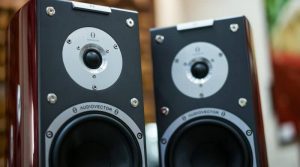Your Complete Home Theater Guide
Going to the movies has been a popular pastime for decades. By building your own home theater, you can enjoy your favorite TV shows and films, along with the latest releases, right at home with your family and friends.
But to create the perfect home theater configuration, you’ll need to know what equipment to get and how to set it up for the ultimate experience. Here’s everything you need to create your dream home theater.
Home Theater Display
The first step in building your home theater is to select your display media, typically a TV or a projector. Here’s how to decide which is the right option for you and how to select the perfect display for your home theater.
Choosing the Right TV
Start by determining what size TV you need. How far you’ll sit from the screen will be a key factor, but with a simple calculation, you can find the ideal size. Divide the distance between your screen and your seating area by 1.5, and this will give you an approximation of your TV’s optimal diagonal size. For example, if your sofa will be 118 inches from the screen, you’ll want a screen that’s 78 inches long diagonally. In other words, you need an 80-inch TV.
Next, you need to decide what screen technology you want.
- Light-emitting diode (LED): Probably the most common TV display technology, LED TVs offer a good viewing experience and cater to most budgets.
- Quantum light-emitting diode (QLED): QLEDs can be seen as enhanced LED TVs, with richer colors and a strong backlight, making them ideal for bright rooms.
- Organic light-emitting diode (OLED): With no backlight, OLED TVs are perfect for darker rooms. Their displays offer deeper blacks and more vibrant colors, although this can come at the cost of being harder to see in bright rooms.
If your home theater will be consistently dark, the OLED may be your best option — but bear in mind that OLEDs are among the most expensive TVs. LEDs and QLEDs are better for brighter rooms, and LED TVs are usually the more inexpensive option.
Most TVs now have 4K resolution, which is perfect for a home theater. You can find TVs with a lower resolution than this, but since 4K is now the standard, a TV with this resolution likely won’t eat into your budget.
Choosing the Right Projector
The other most popular display option for home theaters is a projector. Creating a true theater aesthetic, projectors can vary greatly, which means you need to decide what features you want your projector to have.
The brightness of your projector, measured in lumens, will vary depending on the model. For the most accurate measure of brightness, check the projector’s American National Standards Institute lumens measurement — this scale will be the most accurate. The higher the lumens level, the brighter your projector will be.
If you’ll regularly use your projector in a bright room, you’ll need a higher lumen level to see the display. Most home projectors have a lumen range of between 1,000 and 2,000 lumens, which is appropriate for dim rooms. However, if you’ll be using your projector with the curtains open or the lights on, you’ll want your projector to have between 3,000 and 5,000 lumens.
You’ll also need to consider your projector’s resolution. For home theaters, 4K and 1080p resolution projectors are the most common choices, as they offer great picture quality at an affordable price.
Projector vs. TV: Which Is Right for Your Home Theater?
Both TVs and projectors can create an amazing home theater. Here’s a breakdown of each to help you decide:
- Price: Both TVs and projectors are available at various price points, though high-quality TVs are generally more affordable than premium projectors.
- Picture quality: TVs generally offer better picture quality than projectors and can be used more easily in brighter environments.
- Audio quality: The built-in speakers on a TV tend to have a higher sound quality than those in projectors.
- Theater experience: A projector recreates a true theater experience more accurately than a TV.
Home Theater Audio
A home theater’s sound system is just as important as its display. Your home theater audio setup plays a big role in recreating an authentic theater experience, allowing you to hear every bit of dialogue and sound effect.
Types of Speakers
Your speakers will be one of your most essential theater system components. Luckily, you have plenty of options.
- Tower speakers: These speakers provide a range and depth that many other speakers can’t achieve. They’re perfect for a range of uses in your home theater, whether you’re watching a film, gaming or listening to music. Also known as floor-standing speakers, tower speakers are easy to set up since they don’t require mounting. However, they take up floor space, which is a consideration for smaller home theaters.
- Ceiling speakers: If you prefer unobtrusive speakers, ceiling speakers may be your preferred option. Particularly useful in theaters with limited floor space, ceiling speakers can deliver high-quality sound evenly throughout the theater. However, compared to other speakers, their installation is more complex.
- Soundbars: For a speaker that’s easy to set up and doesn’t take up too much space, a soundbar ticks all the boxes. Soundbars might not provide audio as superb or as immersive as other speakers, but they’re one of the most affordable options. They can greatly improve TV or projector audio. When paired with a subwoofer, a soundbar can make the perfect addition to your home theater.
- Surround sound systems: These consist of several speaker types placed in strategic locations throughout your home theater. Usually comprising up to seven speakers and a subwoofer, these systems can create an immersive experience.
All of these audio systems can enhance your home theater. Choosing the right type of speakers will depend on the size of your home theater, your budget and whether the speakers are compatible with your gear. After installation, perform a speaker test with various songs to ensure your speakers will deliver your desired sound quality.
Configuring Your Speakers
Speaker configuration will affect what components you need to buy for your audio system. If you’re going for a soundbar, your configuration will be simpler, and while it may be complex to install, your ceiling speaker configuration will be relatively straightforward, too. However, if you opt for a surround sound system, you’ll have more decisions to make.
First, decide how many speakers you want in your home theater. The most common configurations are 5.1 and 7.1 — the first number is the number of sound points, and the second is the number of subwoofers.
In most cases, each speaker will create one sound point, although some speakers can create several. Soundbars are particularly effective for this. So, if you think seven speakers may be too many for your home theater, you can alternate the configuration. For example, a good soundbar could replace the front three speakers, or you could just reduce the number of sound points.
With 5.1 surround sound, the typical setup would be three speakers in front and two behind so that sound comes at you from all sides. Since the subwoofer will be delivering very low-frequency sounds, it doesn’t matter where it’s placed. 7.1 surround sound systems will have a similar setup but with two additional sound points to create an even more immersive experience.
When setting up home theater speakers, the goal is to create a balanced sound throughout your seating area. You can add or remove speakers to your system as you please, but using an odd number of sound points can create a more evenly distributed sound.
Receivers and Amplifiers
If you want to give your audio system an extra kick, add an amplifier to your home theater setup. By boosting weak audio signals your speakers might miss, an amplifier allows your speakers to pick up a wider range of signals, creating richer sound quality in your home theater.
A receiver can do the same, but usually comes with a few extra features. These features can include HDMI switching, digital inputs and a radio tuner.
When searching for your ideal amplifier or receiver, consider these factors:
- Power: Your speaker’s power output, measured in watts, is how loud it gets without distorting the sound. Aim for an amplifier or receiver with a power rating that matches the high end of your speakers’ recommended range.
- Impedance: Measured in ohms, impedance is the level of resistance in a speaker. To avoid damage to your receiver, ensure your speaker’s impedance rating is equal to or greater than the receiver’s.
- Number of channels: The number of channels dictates how many speakers your receiver can handle. Is there a subwoofer jack or surround sound jacks?
- Connectivity: Ensure your receiver has enough HDMI inputs, plus a few extra to accommodate future expansions. An enhanced audio return channel is also essential if you want to use your TV’s built-in streaming apps.
Your Home Theater’s Entertainment Source
Where you get your entertainment is almost as important as how you enjoy it. Here are some of the most popular sources of entertainment in a home theater:
Streaming Devices
Streaming devices are becoming increasingly popular. Whether it’s a smart TV with streaming apps or a dedicated USB stick, these devices can give you access to hundreds, if not thousands, of TV shows and movies. These devices require an internet connection, and most of them are only available with a subscription.
Blu-ray/DVD Players
Many film lovers prefer the reliability of physical media. Unlike streaming platforms, which usually offer a rotating mix of TV shows and movies, Blu-rays and DVDs allow you to always watch your favorites.
There are a few differences between Blu-ray and DVD players, but they operate similarly and share a few features. The main difference in your home theater will be that Blu-rays provide much better visual and audio qualities than DVDs. Neither system requires an internet connection, which gives you more freedom to enjoy your collection whenever you want.
Gaming Consoles
If you’re looking for some fun home theater setup ideas, game consoles such as a PlayStation and Xbox give you a whole new way to enjoy your theater. From the thrill of playing your favorite games on the big screen to hearing iconic video game soundtracks on your sound system, it’s an experience that you can’t replicate elsewhere.
Modern gaming consoles also allow you to stream videos online, and if they have a disc tray, you’ll likely be able to watch Blu-rays on them, too.
Turntables
While you won’t be able to use them to watch your favorite shows, turntables create another way to enjoy your home theater system. Listening to vinyl records with your home theater’s sound system means you’ll hear your favorite songs and albums like never before.
Connecting and Setting up Your Home Theater
As you set up your home theater, some of the most common and important connections you’ll need are:
- HDMI cables: These connect your media source to your display system. Make sure your HDMI cables are long enough and of high quality.
- Ethernet cable: Connect an Ethernet cable from your internet router to your source to reduce the chances of internet lag hindering your theater experience.
- Speaker wires: Speaker wires may be needed to connect your speakers to your amplifier.
Many of your devices may connect via Bluetooth. You won’t need any hardware for this, but if you want to take advantage of Bluetooth, make sure your devices are compatible.
Accessories to Complete Your Home Theater
There are several accessories you can add to enhance your home theater experience, such as:
- Seating: Good seating is vital if you want to comfortably enjoy your home theater for hours at a time. Choose between comfortable sofas, love seats or reclining chairs for a cozy setup.
- Mounts and stands: You can use mounts and stands for your display or speakers for maximum enjoyment. When setting up your TV or projector, make sure the image is at eye level so viewers don’t have to crane their necks to watch.
- Acoustic panels: Installing acoustic panels in your home theater can enhance the audio quality. You can also install soundproofing panels to keep noise contained in the space.
- Refreshment bar: If you want to replicate a commercial cinema down to the last detail, setting up your own refreshment bar is a fun way to do it. Add a popcorn machine, movie theater sweets and a mini fridge with drinks to give guests the perfect experience.
Build Your Dream Home Theater With Record Head
At Record Head, we have a great reputation for selling high-quality new and used media at competitive prices, including everything you need for your home theater’s audio system. We also sell video game consoles and video games, plus Blu-rays and DVDs that can transform your home theater experience. All of our media is tested and sold with a 30-day warranty.
Enjoy home theater essentials you can trust from Milwaukee’s longest-running record store. Stop by our store or contact us online today!









